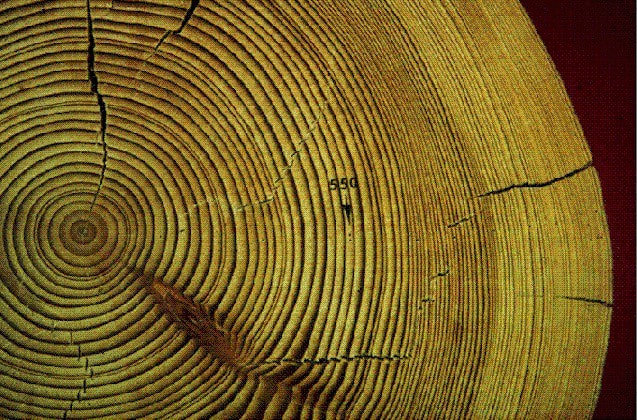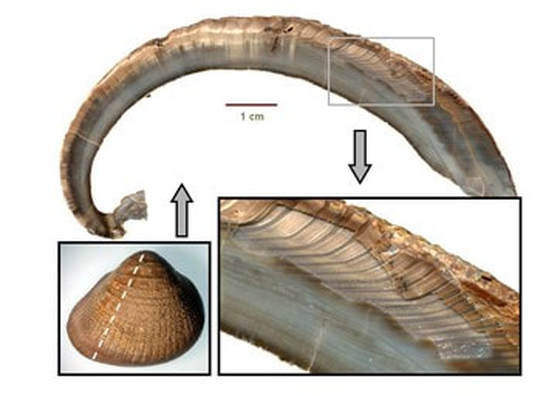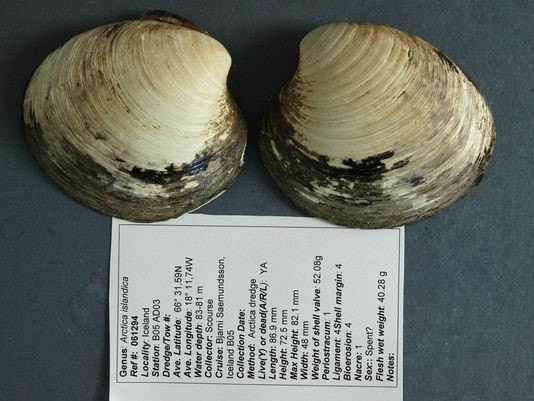|
On my homepage, I describe myself as a paleontologist, and while that is technically true via my training, I wear a few other “hats” as well. One of them is sclerochronology, which is “the study of periodic features in the skeletal portions of marine organisms” (Jones 1983). Huh? Ok let’s back up a bit here. I am sitting in my office at UNC looking out the window (as I often do) at a very large Oak tree. UNC is the oldest public university in the United States. It was chartered in 1789 and began admitting students in 1795 (unc.edu). If you have never been, the campus is quite beautiful and fits almost perfectly the image of what some might call southern charm. Thanks to large expanses of red clay throughout the state, most of the buildings on campus are made from red bricks and many have large, white columns dawning their entries. The university has done a great job landscaping and has had the foresight to preserve as many trees as possible. Some of these trees are quite large, especially the one outside my window. I have not measured, but I’d guess it must be over 60 feet tall and the base of the trunk is at least 4 feet in diameter. So how old is this magnificent oak tree? Did it sprout during the colonial days of the university? How do we find the answer? Cut it in down! Why? Because, as you might already know, trees produce rings as they grow. Since the tree is alive, we could count up the number of rings and subtract that from the current year to determine its birthday. Ok, let’s fire up the chainsaw…wait, I think the university (and my wife) might have some reservations not only about losing this tree, but also my lumberjack skills. http://web.utk.edu/~grissino/treering-gallery1.htm - go here to learn much more about dendrochronology and see some really neat images. Believe it or not, there is an entire field of science dedicated to studying tree rings. It is called dendrochronology (Dendron=tree, chronos=time, logos=study of). The term sclerochronology is derived from the word dendrochronology. Instead of studying trees, sclerochronologists study the hard parts of marine organisms like corals, clams, and oysters. It turns out that like trees, these organisms produce growth increments (we use the term increment instead of ring) throughout their lifespans. From (Buick and Ivany 2004). The long-lived (>100 years) fossil bivalve Cucullaea raea from Seymour Island, Antarctica. Cutting the shell in half reveals annual growth increments that are used to determine lifespan and growth rate. Each couplet of a light and dark increment represents on year of growth. So what good are growth increments preserved in the shell of a clam? In other words, who cares? Well, it turns out that much like trees, the variations in increment widths and values of oxygen isotopes from the shell material (for a post at a later date) can tell us a lot about past temperatures. This is extremely useful because the longest continual instrumental temperature record “only” goes back to 1659 (https://www.metoffice.gov.uk/hadobs/hadcet/). Thankfully, clams and other marine organisms can help us extend climate records much deeper into the past. Because of its long lifespan, one of the most widely used clam species in sclerochronology is Arctica islandica (often called the ocean quahog or northern quahog). We have known for a few decades now that off the Atlantic coast of the United States individuals of A. islandica can live over 200 years. Think about that the next time you eat clam chowder! A 200 year old clam…now that rubbery texture makes sense! A group of scientists from Bangor University in the United Kingdom was well aware of this and decided to use A. islandica for climate studies in Iceland, where the species is also abundant. To their surprise, they found an individual that was 507 years old! Affectionately referred to as “Ming” (because it was alive during the Ming dynasty), the individual was at the time the record holder for maximum reported lifespan of any non-colonial animal (this honor may now go to a deep sea oyster Wisshak et al. (2009)). Unfortunately, Ming was alive when it was collected so the scientists accidentally killed the oldest animal on the planet. Oops! Their so-called “mistake” caught some negative attention from the media. However, because A. islandica grows extremely slow, it is very hard to distinguish between a 200 and a 500-year-old clam based on size and their mistake is forgivable. Never fear though, the statistics of maxima tell us that with more sampling, we would likely find an older individual. “Ming” a 507 year-old clam found off the coast of Iceland (https://www.usatoday.com/story/tech/2013/11/15/newser-worlds-oldest-animal/3574863/) I am a paleontologist. Why do I also wear a sclerochronology hat? My research interests lie in understanding how the so-called “pageant of life” has unfolded throughout Earth’s history. Typically, when we study evolution in the fossil record we look at changes in morphology (size and shape) over time. One way to bring about dramatic changes in morphology, is to change life history parameters such as growth rate and lifespan –though in most animals these are hard to measure. Clams were one of the earliest marine organisms with hard parts and have been on the planet for around 540 million years. We know a good deal about the lifespans and growth rates of modern clams, but almost nothing about those from the fossil record. This is a completely untapped field of research. Using sclerochronological techniques applied to modern and fossil clams some of the questions I hope to answer include: what controls lifespan (see Moss et al. (2016) and Moss et al. (2017)); what are the biological consequences of environmental change (my postdoc work at UNC); is lifespan a trait that passed from ancestor to descendant; what is the pattern of lifespans and growth rates in clams (and their relatives) across the Phanerozoic (540 million years ago until now). References
Buick DP, Ivany LC (2004) 100 years in the dark: Extreme longevity of Eocene bivalves from Antarctica. Geology 32:921–924. doi: 10.1130/g20796.1 Jones DS (1983) Sclerochronology : Reading the record of the the Molluscan Shell: Annual growth increments in the shells of bivalve molluscs record marine climatic changes and reveal surprising longevity. Am Sci 71:384–391. Moss DK, Ivany LC, Judd EJ, et al (2016) Lifespan, growth rate, and body size across latitude in marine bivalvia, with implications for Phanerozoic evolution. Proc R Soc B. doi: 10.1098/rspb.2016.1364 Moss DK, Ivany LC, Silver RB, et al (2017) High-latitude settings promote extreme longevity in fossil marine bivalves. Paleobiology 43:365–382. doi: 10.1017/pab.2017.5 Wisshak M, López Correa M, Gofas S, et al (2009) Shell architecture, element composition, and stable isotope signature of the giant deep-sea oyster Neopycnodonte zibrowii sp. n. from the NE Atlantic. Deep Res Part I Oceanogr Res Pap 56:374–407. doi: 10.1016/j.dsr.2008.10.002
1 Comment
Nathan Atterberry
8/24/2023 05:04:47 pm
Very informative! Great read!
Reply
Leave a Reply. |
AuthorDavid Moss. Paleontologist. While most of my blog posts will relate to my research, from time to time I plan to write about something completely unrelated. I like to tell stories to communicate scientific ideas. Hopefully they will be entertaining as well as informative.
Archives
November 2020
Categories |



 RSS Feed
RSS Feed
